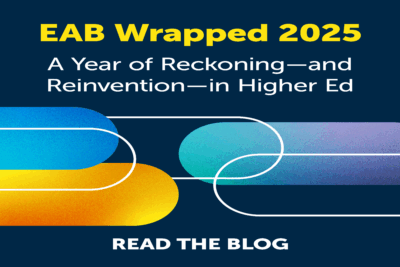Supporting undergraduate research and challenging assumptions
-
The views and opinions expressed are those of the author and do not necessarily represent the views or opinions of EAB.
By: R. Gabe Cavazos, Assistant Vice President for Research Data and Information Systems, University of Texas at Dallas
A robust undergraduate research program benefits students and institutes of higher education[1]. For the students, it may be intuitive that the opportunity to develop critical thinking[2], teamwork, leadership, and presentation skills provides a practicum for future careers in addition to direct academic benefits[3]. For the institute, it offers direct support to research personnel and projects that comprise the university’s core mission.
At the University of Texas at Dallas, I have supported research activities through system development and information technology but have not historically been involved with student programs. However, having been indirectly exposed over the years to a deluge of anecdotal reports from students expressing difficulty obtaining access to undergraduate research opportunities, I became interested in exploring more holistic support for undergraduate research programs, specifically from my central research office (CRO) role.
Are students having trouble due to lack of availability? Could it be a lack of defined processes for labs to equitably identify and onboard students? Or is it something else entirely that might bolster the ultimate goal of increasing the number of students capitalizing on these opportunities?
In my EAB capstone project, I sought to identify areas a CRO can support these undergraduate research initiatives, using data to identify potential opportunities for improvement and begin the process of better supporting these activities. I connected with our office of undergraduate education and sorted through intake and exit survey data from our students. Curious to whether this data supported the anecdotes I’ve heard over the years, I was pleased to see there were direct questions related to access, awareness, and interest.
From the data, only 13% of surveyed students indicated trouble accessing opportunities, varying from 1%-22% by school with the highest percentages in STEM programs. Put in perspective, a much larger portion of students indicated a lack of interest or awareness-up to and over one third[4]-which may indicate that the overall situation is more nuanced than previously realized.
Although there are opportunities to address the direct gaps in access, it appears there may also be significant opportunities to increase interest via awareness and outreach programs.
As a result of this information, I have proposed some initial steps for our institution, including the ongoing reevaluation of success via these annual student surveys. These steps may include:
1. Re-evaluate resource priorities
A thorough evaluation and tightening of current programs would allow strategic investment of current resources to address other gaps, potentially with the ideas below.
2. Start outreach earlier
Go to where the students are. Initiate presence at freshman orientation and 101 classes to increase awareness.
3. Lengthen availability of current programs
Currently, matchmaking and research fair programs occur once a year for a week. Instead, these programs could be held biannually, or spread out over longer timeframes, increasing the opportunities for students to connect.
4. Engage and incentivize new faculty mentors
Provide tools for onboarding and supporting undergraduate researchers, and advocate towards additional considerations for undergraduate research mentorship in promotion and tenure activities to further incentivize participation and increase the overall number of opportunities.
Although my initial intuition was to address these anecdotal reports with systems and processes-which will still likely be part of the solution-the data instead shows that awareness and outreach are the key aspects to consider as we begin creating a plan of action. With these proposed ideas, and the goal of our central research office playing a larger part in the success of these valuable activities, I hope we can begin to better support stakeholders of undergraduate research programs.
References
- Barron, S. I., Brown, P., Cumming, T., & Mengeling, M. (2020). Impact of Undergraduate Research and Student Characteristics on Student Success Metrics at an Urban, Serving, Commuter, Public Institution. In Journal of the Scholarship of Teaching and Learning (Vol. 20, Issue 1). IUScholarWorks.
- Petrella JK, Jung AP. Undergraduate Research: Importance, Benefits, and Challenges. Int J Exerc Sci. 2008;1(3):91-95. Published 2008 Jul 15.
- Rodenbusch, S. E., Hernandez, P. R., Simmons, S. L., & Dolan, E. L. (2016). Early Engagement in Course-Based Research Increases Graduation Rates and Completion of Science, Engineering, and Mathematics Degrees. In J. Knight (Ed.), CBE-Life Sciences Education (Vol. 15, Issue 2, p. ar20). American Society for Cell Biology (ASCB).
- 35% based on 2021 Enrollment Factors Survey of 5608 students. 37% based on 2021 Freshman and Transfer Exit Survey of 1755 students. Source: Courtesy of UT Dallas Office of Undergraduate Education
More Blogs

Is your yield rate okay?

EAB Wrapped 2025: A year of reckoning—and reinvention—in higher ed
